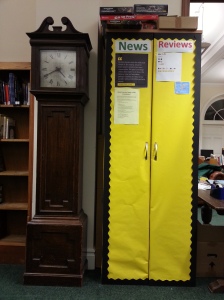Shakespeare Documented is the largest and most authoritative collection of primary-source materials documenting the life of William Shakespeare (1564-1616), bringing together all known manuscript and print references to Shakespeare, his works, and additional references to his family, in his lifetime and shortly thereafter.
Phil Earle: I want to help children find their life-changing book
Award-winning novelist for children and young adults, Phil Earle, has been appointed the new online Writer in Residence for children’s reading charity, BookTrust.
Today, (Monday 18 Jan) Phil kicks off his six month residency with a vlog talking about his belief that everyone is a reader and that there is a story out there for everybody.
Phil said: I’m chuffed to bits to be working with BookTrust as their Writer in Residence. Growing up as a non-reader, I had no idea about the power of stories: of the places they can take you or the people you can meet as a result. I really want to show children that the right book for them is out there.
It wasn’t until Phil was 26 years old that he stumbled across children’s literature by accident, after being ‘kicked into the children’s section’ whilst working in a bookshop.
After that ‘light-bulb’ moment Phil’s life changed and he began writing his own stories in his lunch breaks in the bookshop and, later, writing on the bus on his way to work.
During Phil’s residency he plans to interview authors, editors, poets and illustrators on his vlog in the hope of encouraging children to find the right story, graphic novel, picture book for them. Phil will host a Writer in Residence Twitter chat on 12 February at 2.30pm. His focus will be on favourite fictional families in children’s books and the chat will use the hashtag #philbookchat. Follow Phil on @philearle to take part.
Phil’s books include gritty young adult titles Heroic and Being Billy, the latter being nominated for the Carnegie Medal and shortlisted for the Waterstones Children’s Book Prize. More recently, Phil wrote Demolition Dad, the first in a middle-grade series described as ‘DANNY, CHAMPION OF THE WORLD in Spandex’ about a young boy and his Dad who’s an amateur wrestler on the weekends. The sequel, Superhero Street is forthcoming in March from Orion. Phil has also authored a couple of early reader titles for Orion including the football-themed Albert and the Garden of Doom.
Whilst writing popular children’s books, Phil also works as Sales and Marketing Director at David Fickling Books.
BookTrust chief executive Diana Gerald said: The BookTrust online Writer in Residence programme has been a wonderful and popular addition to the BookTrust website, giving visitors to the site a sneak peek into the lives, notebooks and sketchbooks of acclaimed writers and illustrators. We are really looking forward to Phil’s residency as he helps us in our ongoing mission of championing reading to children.
The BookTrust Writer in Residence project has been running since March 2009 and has featured a number of authors and illustrators including Sita Brahmachari, Patrick Ness, Nii Ayikwei Parkes, Evie Wyld, Polly Dunbar, Clare Wigfall, Bali Rai, Hannah Berry, Matt Haig, Laura Dockrill, Chris Riddell and Philip Ardagh. The residency encourages each writer to explore topics that they, and BookTrust, are passionate about, with past residents exploring themes such as LGBT issues, diversity in children’s literature and the importance of libraries.
Listen to Phil’s first vlog here:
http://www.booktrust.org.uk/books/writing/online-writer-in-residence/blog/936
The Mind’s Treasure Chest
A long, long (ish) time ago I was a student librarian in the School of Education at the Cape Technikon (now the Cape Peninsula University of Technology). It was during the second year of my studies that one of my favourite lecturers (Dr Liz van Aswegen) showed my class a video called The Mind’s Treasure Chest
Released in 1991, THE MIND’S TREASURE CHEST is a feature length educational comedy that teaches students to think for themselves. This film is a marriage between a Hollywood movie and an educational video. It’s about libraries, research, and information. It’s about history and hypothesizing. It’s about thinking for yourself.
Distributed in five countries, it won a multitude of awards, including Best Film for Grades 7 – 12 at the National Educational Film and Video Festival.
For Kennedy buffs, the film features a number of sequences that dramatize the history of the Bay of Pigs and the Cuban Missile Crisis.
Parts of it are a bit dated, for example I do not think that many (or any) school libraries still use microfiche readers; catalogues are computerised and the internet is now available on broadband rather than a limited dial up service.
You may be able to show it to your students as part of their library induction or get them to spot the ways that school library usage has changed (and indeed, remained the same) but if not it is still an entertaining and educational film for Librarians to watch and reminisce on how things used to be done.
Making use of Limited Display Space

My School Library, while being a classically beautiful and retro (in appearance) library space while at the same time managing to be fairly modern in offering a relevant, 21st Century service is rather limited in display space, owing to nearly every available wall being covered in bookshelves.
In December of 2015 I decided to turn my storage cupboard (one of the few usable forward-facing flat spaces) into a display board, which you can see on the left alongside my beautiful grandmother clock.
The other flat spaces are between the windows, but use of this space is tricky due to the ban on anything sticky being attached to painted walls. To get round this, I attached poster paper to the window frames on each side to create a semi-permanent display advertising the library clubs that I run on a weekly basis
Has anyone else had to get round limited display space in inventive ways? If yes I would be interested in hearing how this was accomplished.